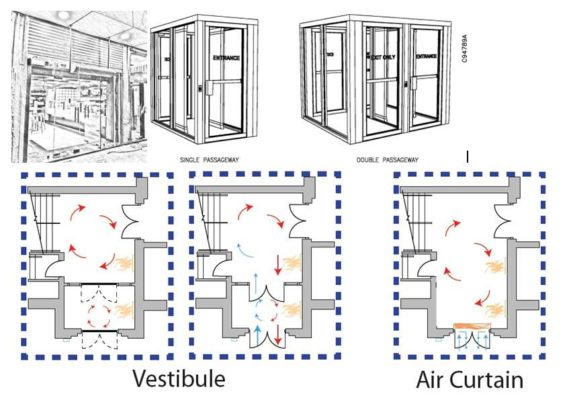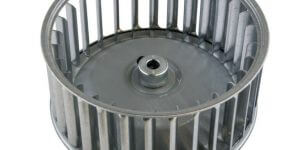
FAQ’S AND ANSWERS RELATED TO AIR CURTAINS


According to AMCA International study on ‘Investigation of the Impact of Building Entrance Air Curtain on Whole Building Energy Use’, In comparison to the vestibules, Air curtains save 10% more energy in environmental separation performance, Cuts up to 75% of the cost in labor and materials.
This research has proved that air curtain helps one save thousands of dollars as a substitute for vestibule when it comes to construction cost.
These are the 5 Secret of Air Curtain Benefits-

1. More Spacious
As per the research study, Not only does air curtains save us energy used in installation over a vestibule, It also cuts the construction cost and gives us more floor space. Air curtains are easily fixed at the roof of the doorway.

2. Open Door Policy
With Air Curtain benefits in place, you can keep a door open for all the working hours, many psychological studies have proved that walk-in customers increase in a premise if the door is open then when it is closed.

3. Energy conserver
Air curtains are also a great energy saver if we reduce the heat or cold air transfer between two spaces. Air curtains enable us to keep the entry door open longer than vestibules. Air curtains are the machines that help in meeting the demands of specific door sizes and environments. It conserves up to 80% of the energy through doorways.
4. Design flexibility
Air curtains form an invisible barrier which prevents the premises from the polluted air outside the premises without making any changes to the design of the building.
Air curtains are most efficient in premises where doors are left open for longer durations. Apart from being installed at the entryways, Air curtains benefits are also useful in the inner parts of a building such as the entrance of storage or packaging area.
5. Pay Back period
The construction and energy savings that air curtain offers sums up to a very fast payback period of up to 6 months in case of air conditioning applications and as low as one month in case of hot oven applications.
Different applications of air curtains:
Cold Room air curtains
These air curtains consist of a powder covered aluminum casing, with plastic inward grills and stainless steel main and mounting plates, to make it rust free. They use airfoil designed centrifugal blowers which produce high air flow.
Industrial air curtains
These air curtains, have a rugged construction with high static which is achieved by using bigger diameter blowers and lower RPM. They incorporate the forward curved aluminum blower wheels.
Hot Oven air curtains
Hot Oven air curtains beside having rugged look, the placement and installation are very important, they generally incorporate a special kind of arrangement in which the whole air curtain can swing and the air is made to flow from bottom to Top.

Controlling indoor temperatures, saving energy and keeping debris and pests outdoors is a major challenge you can experience if you are a home or business owner then air curtain need for you. It is even worse if you live in a heavy traffic area. Air curtains, also called air doors are devices designed to deliver constant airflow across an opening i.e. window, home, business or garage door.
They are common in many industries and have been installed above entry doors in restaurants, offices, and shops. Air curtains are tall and can cover 6 meters doors. Installing an air curtain in your business is the best move you can make in mitigating a vast range of concerns. Here are some of the benefits and why your business an air curtain need.
Air curtains also allow maximum entry of natural light. This reduces instances of collisions and prevents ice from forming on the floors of your business premise. Additionally, in the case of emergencies, it makes it easy to evacuate a building. If you are planning to install air curtains in your business premise, then consider hiring a professional to do it.

Most commercial, industrial and residential establishments these days use an air door for a major reason – cutting their monthly electric consumption. Remarkably this piece of equipment has proven such relief in the payment of electricity bills to those who have been using it.
If you do not quite understand how the saving of energy happens, let us first have an overview of how it works. This device, which is commonly placed at the entrance of most structures, functions in the concept of directing an invisible stream of cooled or heated air downwards. This same concept makes it very effective in trapping the cooled or heated air inside the room or building.
An air door works hand in hand with an air conditioner which may be used as a cooler or a heater. Once a place is being cooled or heated, the internal air is being kept inside by this piece of technology while the external air is being prevented from coming in. Thus, it reduces the energy an air conditioner has to use up in expelling cooled or heated air. Moreover, it reduces the heat transfer between two spaces especially spaces that are being cooled and are impossible to be separated by a real door in place.
Since more and more establishment owners have seen the energy saver quality of this device, air door manufacturers have mass-produced it in different sizes. There are sizes that will suffice for the cooling or heating needs of a small room or a spacious warehouse.
Designed to provide a steady gush of cooled or heated air, they are very valuable during cold and warm months of the year. During winter, they help lighten the load of heating systems. They trim the loss of heated air which flows out of open entrances. Come summertime they reduce the intensive use of air coolers as they prevent the loss of cool air. More than that they function as a repellent to dirt, dust, and fumes which affects the conditioning – cooling or heating – of air in a certain place.
In connection with this, the high technology that air curtains possess creates an invisible wall of air. This air wall serves as a barrier that divides two environments of different temperatures even with the absence of a door. Hence, air from outside that may contain the above-mentioned pollutants is blocked and the conditioned air inside a place remains clean and intact. Sound like the function of an air purifier too, right?
Next, to be an air purifier, it also functions as an air knife. This is perfect for any spot cooling needs. Instead of using additional pieces of equipment for these, an air door can do this single-handedly. Again, much energy and money are saved.
Besides saving energy, a door air curtain also saves time – time spent in combating the different flying insects that may infest any place. You do not have to worry anymore about the health hazards you might catch from these filthy creatures as the air wall air curtains produce shall force their exit.

Cost of Opening a Door =7
Energy Calculation
E = m C ∆T
m : Mass of Air
C : Specific heat of Air at given Temperature
∆T : Temperature Difference
m = Density X Volume
Density of Air at 40˚C = 1.127 Kg/cu. meter
C = Specific Heat = 1.005 KJ / (Kg ˚C)
∆T = Temperature Difference = 15˚C
(assuming outside temperature is 40˚C and inside is 25˚C)
Volume = Area X Velocity of Air from Door X Time of Opening
(Say : Door Size = 8ft X 4 ft
Velocity = 1 m/s = 200 fpm
Time of Opening = 1 min
Volume = 32 X 200 X 1 = 6400 cu. ft. = 181.22 cu. meter)
m = Density X Volume
(from Above = 1.127 Kg/cu. meter X 181.22 cu. meter
= 204 Kgs)
E = m C ∆T
= 204 kgs X 1.005 KJ / (Kg ˚C) X 15˚C
= 3075.3 KJ = 0.85425 KWh
Thus –
India if Per KWH cost of Power is Rs 8.10
Cost of Opening the Door of Size 8ft X 4ft for 1 min is = Rs 6.92
Cost of Running an Air Curtain of 4 ft = 400W (Input Power) for 1 minute = 6 paise
Rate per Kwh X Time X Power Input
8.10 X 1/60 X 0.4 = 5.4 paisa
Net Saving = Rs 6.92 – 0.06 = Rs 6.86

A centrifugal fan (often referred to as a coop fan) may be a machine used for moving air or different gases because of their straightforward style, centrifugal fans area unit factory-made easier than different kinds of fans that saves time and prices. This makes them a well-liked alternative for air handling applications.
Through their rotating impellers, with either forward- or backward-curved blades, centrifugal fans increase the speed & the volume of an air stream and have superior mechanical properties compared to axial fans, as an example.
Energy potency (reaching up to eighty-four static potency), sturdiness even in corrosive environments, simple maintenance, and suitableness for multiple airflow/pressure combos area units the most blessings that engineers take into account once selecting them for HVAC applications.[1]
How to Predict a Centrifugal Fan’s mechanics Efficiency?
As mentioned higher than, its mechanics is one of every of the simplest blessings of a centrifugal fan. This is often why throughout the planning method, it’s necessary to build to form to create} positive that style engineers make the foremost out of its properties to maximize potency. This is often once procedure fluid dynamics (CFD) simulations acquire play.
CFD is that the technique used for the computerized calculation of fan mechanics quality to accurately predict its performance early within the style stage, analyze numerous CAD models, scale back the quantity of physical prototypes and overpriced testing and optimize the planning for optimum performance.
Sim Scale’s CFD resolution permits fan designers to calculate flow rates, static pressure, total pressure, static efficiency, total potency, peak total potency, forces and moments working on the fans and a lot of, 100% within the browser, giving flexibility, collaboration choices and access to high computing power — up to thirty-two cores —from a standard computer or laptop computer.
CFD Analysis of a Centrifugal Fan style
An example is that this CFD analysis, which was performed on the planning of a centrifugal radial compact fan with a forward-curved vane. this sort of fans area unit is used for natural philosophy cooling applications like thermal management for the picture show, IT, and medium systems.
The goal for the 3D simulation was to predict the fan’s mechanics performance and establish areas for style optimization.
The contours below show a 3D visualization of static pressure, flow rate, and also the mechanic’s forces working on the rotor. The performance curves obtained from this analysis area, unit key indicators for deciding whether or not the planning meets the wants or desires optimization.

1. They create an invisible air barrier that inadvertently stops the flow of air from the outside. Creation of an invisible curtain of air enables us to keep the door wide open.
2. Placement of the product is an important task, just above or beside the entrance ensures no movement of air from outside the area. While not doing the same may result in leakage from both areas.
3. There are other ways to support the temperature in a room but air curtains are an advanced technique which allows people to move between rooms without any hindrance.
In the recent times, many industries do not mind spending large amounts to support a healthy setup. But on the contrary, these curtains are highly inexpensive and efficient at work. The setup is quite overwhelming for many, as these air curtains manage temperature even with the door open by forming a thin air layer across the doors. These curtains can manage both hot and cold air, be it inside or outside the confined area.
The air curtains are selected depending on the following factors: